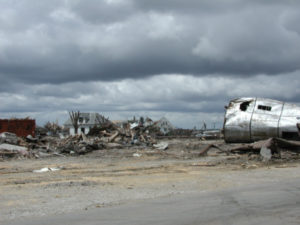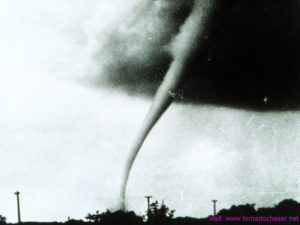Fujita

Enhanced Fujita Scale
Developed in 1971 by Tetsuya “Ted” Fujita (1920 – 1998) “Mr. Tornado” of the University of Chicago
The Fujita Scale is based on structural strength and engineering research done by Ted Fujita and a host of others. This research created the Fujita scale as a measurement of a tornadoes strength or intensity. Simply put, how intense would a wind have to be to move a cardboard box or to move bricks? One questions to ask would be: How fast or intense would the winds have to be to knock over a brick wall,? Obviously those winds would be significant. Through extensive research the Fujita Scale was developed based on damage, not wind speeds. Based on the extent of this damage conclusions are drawn as to what the winds would likely have to be to cause that type of damage. Since two wooden structured homes can be vastly different in quality and strength, there can be some misleading conclusions from the damage. Because of this and other overly general conclusions, storm researchers came up with the Enhanced Fujita scale to better reflect a tornado’s strength. As a storm chaser I have seen EF5 damage that is difficult to comprehend.
I certainly wish I had my DJI drone to get better images of the damage to show you. Drone images show more details then I can get from the ground only.
Here is tornado damage from one of Tornado Tim’s chases.
Enhanced Fujita scale as of February 2007
| Fujita Scale | Derived EF Scale | Operational EF Scale | ||||
| F Number | Fastest 1/4-mile (mph) | 3 Second Gust (mph) | EF Number | 3 Second Gust (mph) | EF Number | 3 Second Gust (mph) |
| 0 | 40-72 | 45-78 | 0 | 65-85 | 0 | 65-85 |
| 1 | 73-112 | 79-117 | 1 | 86-109 | 1 | 86-110 |
| 2 | 113-157 | 118-161 | 2 | 110-137 | 2 | 111-135 |
| 3 | 158-207 | 162-209 | 3 | 138-167 | 3 | 136-165 |
| 4 | 208-260 | 210-261 | 4 | 168-199 | 4 | 166-200 |
| 5 | 261-318 | 262-317 | 5 | 200-234 | 5 | Over 200 |
Enhanced F Scale Damage Indicators
Click on the (Details Linked) number to see more details.
| NUMBER (Details Linked) | DAMAGE INDICATOR | ABBREVIATION |
| 1 | Small barns, farm outbuildings | SBO |
| 2 | One- or two-family residences | FR12 |
| 3 | Single-wide mobile home (MHSW) | MHSW |
| 4 | Double-wide mobile home | MHDW |
| 5 | Apt, condo, townhouse (3 stories or less) | ACT |
| 6 | Motel | M |
| 7 | Masonry apt. or motel | MAM |
| 8 | Small retail bldg. (fast food) | SRB |
| 9 | Small professional (doctor office, branch bank) | SPB |
| 10 | Strip mall | SM |
| 11 | Large shopping mall | LSM |
| 12 | Large, isolated (“big box”) retail bldg. | LIRB |
| 13 | Automobile showroom | ASR |
| 14 | Automotive service building | ASB |
| 15 | School – 1-story elementary (interior or exterior halls) | ES |
| 16 | School – jr. or sr. high school | JHSH |
| 17 | Low-rise (1-4 story) bldg. | LRB |
| 18 | Mid-rise (5-20 story) bldg. | MRB |
| 19 | High-rise (over 20 stories) | HRB |
| 20 | Institutional bldg. (hospital, govt. or university) | IB |
| 21 | Metal building system | MBS |
| 22 | Service station canopy | SSC |
| 23 | Warehouse (tilt-up walls or heavy timber) | WHB |
| 24 | Transmission line tower | TLT |
| 25 | Free-standing tower | FST |
| 26 | Free standing pole (light, flag, luminary) | FSP |
| 27 | Tree – hardwood | TH |
| 28 | Tree – softwood | TS |
Enhanced Fujita Scale article has been completed by the Wind Science and Engineering Center at Texas Tech University.
Thanks to http://www.spc.noaa.gov and http://www.wind.ttu.edu for the new information.
OLD FUJITA SCALE BELOW
| Intensity Phrase | Type of Tornado …….. | Estimated Wind speeds |
| F0……………….Gale tornado………….. winds of 40-70 mph Some damage to chimneys; break branches off trees, pushes over shallow- rooted trees-, damages sign boards. |
| Fl………………. Moderate tornado………winds of 73-112 mph The lower limit is the beginning of hurricane wind speed- peels surface off roofs; mobile homes destroyed. |
| F2……………….Significant tornado……..winds of 113-157 mph Considerable damage. Roofs torn off frame houses- mobile homes demolished; boxcars pushed over; larger trees snapped or uprooted-, light object missiles generated. |
| F3……………….Severe tornado………….winds of 158-206 mph Roof and some wall torn off well constructed houses trains overturned; most trees in forest uprooted |
| F4……………….Devastating tornado……..winds of 207-260 mph Well-constructed houses leveled-, structures with weak foundations blown off some distance; cars thrown and large missiles generated. |
| F5………………Incredible tornado………..winds of 261-318 mph Strong frame houses lifted off foundations and carried considerable distances to disintegrate- automobile sized missiles fly in excess of 100 meters; trees debarked; steel reinforced concrete structures badly damaged. |
| F6……………..Inconceivable……………..winds of 319-379 mph These winds are very unlikely. The small area of damage they might produce would probably not be recognizable along with the mess produced by F4 and F5 wind that would surround the F6 winds. Missiles, such as cars and refrigerators would do serious secondary damage that could not be directly identified as F6 |
 Flying a drone like the DJI Mavic Classic to show the aftermath and destruction of a tornado is helping us see the destruction caused by these terrible twisters.
Flying a drone like the DJI Mavic Classic to show the aftermath and destruction of a tornado is helping us see the destruction caused by these terrible twisters.
Tornado Fiction and Fact

FICTION: Lakes, rivers, and mountains protect areas from tornadoes.
FACT: No geographic location is safe from tornadoes. A tornado near Yellowstone National Park left a path of destruction up and down a 10,000 foot mountain.
FICTION: A tornado causes buildings to “explode” as the tornado passes overhead.
FACT: Violent winds and debris slamming into buildings cause the most structural damage.
FICTION: Open windows before a tornado approaches to equalize pressure and minimize damage.
FACT: Virtually all buildings leak. Leave the windows closed. Take shelter immediately. An underground shelter, basement or safe room are the safest places. If none of those options are available, go to a windowless interior room or hallway.
FICTION: Highway overpasses provide safe shelter from tornadoes. FACT: The area under a highway overpass is very dangerous in a tornado. If you are in a vehicle, you should immediately seek shelter in a sturdy building. As a last resort, you can either: stay in the car with the seat belt on. Put your head down below the windows, covering with your hands and a blanket if possible, OR if you can safely get noticeably lower than the level of the roadway, exit your car and lie in that area, covering your head with your hands. Your choice should be driven by your specific circumstances.
FICTION: It is safe to take shelter in the bathroom, hallway, or closet of a mobile home.
FACT: Mobile homes are not safe during tornadoes! Abandon your mobile home to seek shelter in a sturdy building immediately. If you live in a mobile home, ensure you have a plan in place that identifies the closest sturdy buildings.
From NOAA/PA 201051 on weather.gov